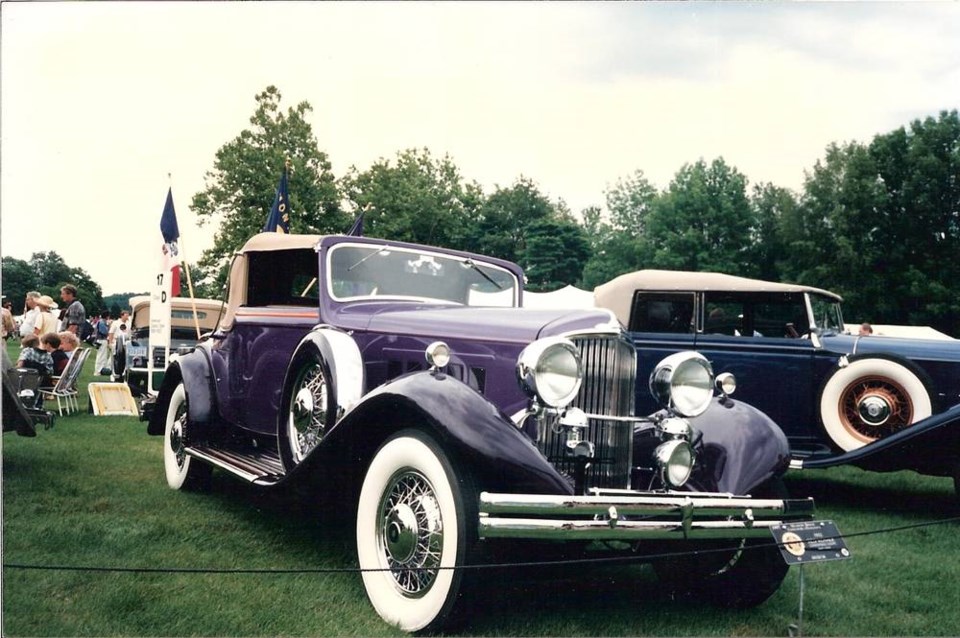It seemed natural that Ransom Eli Olds would enter the automobile business; the trail had already been blazed. His family’s company, P.F. Olds & Son (the son was Ransom’s older brother Wallace), was one of the largest gasoline engine manufacturers in Michigan in the late 1800s.
Talented young Ransom experimented with steam engines but decided gasoline power was the future. He produced his first gas car in 1896 and organized Olds Motor Vehicle Co. in Detroit in 1897.
Olds’s new company soon experienced financial problems, but with funding from Michigan lumber magnate Samuel Smith he reorganized as Olds Motor Works in 1899. Several experimental models were made before fire levelled the plant in 1901. The only vehicle saved was a small curved dash runabout.
The company was soon back in business, now in Lansing, Michigan, building the only thing it had, Curved Dashes. They were capable, inexpensive little machines, so popular they became world’s the first mass produced car.
Unfortunately, Olds and Smith disagreed. Olds favoured entry level cars like the Curved Dash while Smith wanted heavier, more luxurious vehicles. Unable to reconcile, Olds left the company in 1904.
Olds organized another car company, R. E. Olds Co. which immediately brought a lawsuit from Smith for using his name after just selling to Smith. Olds reasoned that he sold his name but not his initials and re-named his new Lansing-based company Reo.
Reo Motor Car Co. showed its first light, one-cylinder model at the 1905 New York Automobile Show. A two-cylinder was soon added and the company prospered, trailing only Ford and Buick in sales by 1907.
The introduction of Ford’s Model T in 1908 convinced Olds the Reo needed more than two cylinders. In 1909 it introduced a low priced 35 horsepower, 3.7 litre (226 cu in.) four with F-head design (inlet valves in the cylinder head and exhausts in the block).
This and subsequent car and truck models — Reo entered the commercial market in 1908 — helped it prosper. A six-cylinder F-head was introduced in 1916, and by emphasizing quality over quantity Reo’s solid reputation carried it through the early 1920s recession.
In 1927 Reo introduced its well regarded Flying Cloud model named to suggest the smooth quietness of a fast clipper ship. The Flying Cloud abandoned the F-head for a conventional L-head 65 horsepower, 4.1 litre (249 cu in.), seven-main-bearing six. Reo was an early user of four wheel hydraulic brakes and had a rounded and gracefully styled body.
The Flying Cloud expanded to two models in 1929, three in 1930 and four in 1931. Profit exceeded $5 million in 1928 and management did seem to be sailing on a cloud of optimism.
Unfortunately, the 1929 stock market crash found Reo badly over extended. Ransom Olds had turned the operation over to hired managers but he quickly returned to active participation. He reorganized, appointed a new general manager and cleared the unsold inventory at reduced prices.
For 1931, Reo did what some others were also doing and defied the plunging economy with a large, powerful, expensive car. The mighty Reo Royale arrived in a world mired in the Depression. It was the wrong car for the times.
The Royale’s lines flowed gracefully from a V-shaped grille and nicely rounded fenders. Its 3,429 mm (135 in.) wheelbase was 127 mm (5 in.) longer than the longest Cloud (a few 3,861 mm [152 in.] wheelbase chassis were produced for custom bodies.)
The Royale’s 5.9 litre (358 cu in.) side-valve, nine-bearing inline eight developed 125 horsepower. The Royale had Reo’s patented “silent second gear,” automatic chassis lubrication and thermostatically controlled radiator shutters.
Reo introduced its expensive, innovative “Self-Shifter” semi-automatic transmission in 1933, but there were problems. Hopes of recovering their investment by selling it to other manufacturers didn’t materialize.
Unfortunately, the Royale and other models during the economic downturn would not be able to save Reo in the deepening Depression.
The Reo Flying Cloud was briefly assembled in sa���ʴ�ý in the early 1930s by Dominion Motors in Toronto, formed out of failed Durant Motor Co. of sa���ʴ�ý. Reos were also assembled in St. Catharines, Ontario, prior to the Second World War.
By 1936, Reo’s car building ended. Funeral car business and selling engineless cars to Franklin Automobile Co. who fitted their air-cooled engines and sold them as Franklins was not enough.
Reo continued manufacturing trucks but Olds wasn’t much interested in them. He left the company in 1937 and died in 1950, the last of the early American automobile pioneers.
Reo continued making well respected trucks and buses, and was bought by White Motor Co. in 1957. White also purchased Diamond T and consolidated them into Diamond-Reo in 1967. Diamond-Reo’s bankruptcy in 1975 marked the end of the line for the Reo name.



